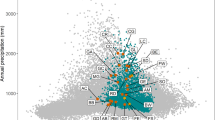Summary
The effective population size for inbreeding has been estimated in a 70 years old population of Scotch Pine in three consecutive years to be 0.46, 0.55 and 0.61 respectively of the actual total population. The following formula was developed to determine differences among trees as regards their male or female flowering and their “maleness” and “femaleness”:
wheren e is the total effective population size for inbreeding,n e ′ the male effective part,n e ″ the female effective part, andM a measure for monoecy ranging in values between zero (dioecy) and unity (ideal monoecy). The degree of monoecy was 70, 82 and 78 percent respectively in the three years.
Correlation between male flowering over the three years was fairly strong; the same was found for female flowering. But correlation between male and female flowering was weak, both within the same year and over the three year period. Correlation of numbers of female strobili and numbers of ripe cones was weak also.
The population model on which the above formulae is based is that of a clonal ‘Seed Orchard’ where seedlings of several clones are randomly distributed on evenly spaced plots.
Zusammenfassung
Die Inzucht-effektive Populationsgröβe ist in einer 70 Jahre alten Population von Kiefern in 3 aufeinanderfolgenden Jahren zu je 0.46, 0.55 und 0.61 Anteilen der realen Populationsgröβe geschätzt worden. Um den Unterschied zwischen männlichem und weiblichem Blühen der Bäume zu messen, ist die folgende Formel hergeleitet worden:
Hierin istn e die totale Inzucht-effektive Populationsgröβe,n e ′ der männlich-effektive Teil,n e ″ der weiblicheffektive Teil undM ein Maß für Monözie, welches Werte zwischen 0 (Diözie) und 1 (ideale Monözie) annimmt. Der Grad an Monözie wurde innerhalb der 3 Jahre zu 70%, 82% und 78% gemessen. Die Korrelation zwischen den männlich Blühenden während jener 3 Jahre war bemerkenswert stark; gleiches wurde für weibliches Blühen gefunden. Andererseits jedoch war die Korrelation zwischen männlichem und weiblichem Blühen sowohl innerhalb desselben Jahres als auch über die 3 Jahre schwach.
Der obigen Gleichung Hegt das Modell einer Samen-plantage zugrunde, die mit je mehreren Pfropflingen vonn-Klonen begründet wurde. Es wird angenommen, daß die Pfropflinge zufallsmäßig auf die Pflanzplätze der Samenplantage verteilt sind.
Similar content being viewed by others
Literatur
Crow, J. F.: Breeding structure of populations. II. Effective population number. Statistics and Mathematics in Biology, pp. 543–556. Ames, Iowa: Iowa State Coll. Press 1954.
Crow, J. F., Morton, N. E.: Measurement of gene frequency drift in small populations. Evolution9, 202–214 (1955).
Crow, J. F., Kimura, M.: An Introduction to Population Genetics Theory. New York-Evanston-London: Harper & Row 1970.
Kimura, M., Crow, J. F.: The measurement of effective population number. Evolution17, 279–288 (1963).
Stern, K.: Ueber die Abhängigkeit des Blühens der Sandbirke von Erbgut und Umwelt. Silvae Genetica12, 26–31 (1963).
Wright, S.: Evolution in Mendelian populations. Genetics16, 97–159 (1931).
Wright, S.: Size of population and breeding structure in relation to evolution. Science87, 430–431 (1938).
Author information
Authors and Affiliations
Additional information
Die Autoren danken der Deutschen Forschungsgemeinschaft, die durch eine Sachbeihilfe die obige Untersuchung ermöglicht hat. Sie danken ferner Herrn Oberforstmeister Sellhorn, Leiter des Niedersächsischen Forstamts Oerrel, der seit mehreren Jahren die Untersuchungen des Lehrstuhls für Forstgenetik und Forstpflanzenzüchtung über das Breeding System der Kiefer in seinem Forstamt unterstützt.
Rights and permissions
About this article
Cite this article
Stern, K., Gregorius, H.R. Schätzungen der effektiven Populationsgröße beiPinus silvestris . Theoret. Appl. Genetics 42, 107–110 (1972). https://doi.org/10.1007/BF00583411
Received:
Issue Date:
DOI: https://doi.org/10.1007/BF00583411




